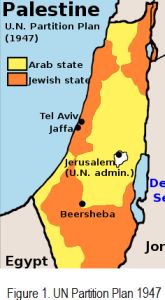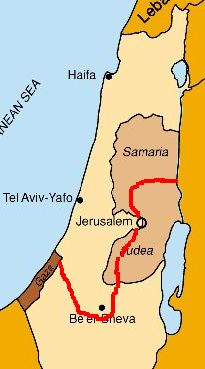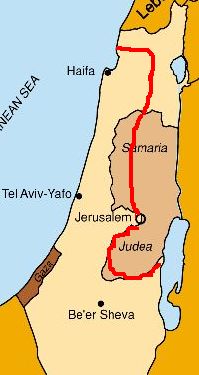Israel and Palestine
November 2012
There is, as we know, a land that Jews, Christians, and Muslims all call the Holy Land, where these three groups of believers have been honoring God by killing one another wantonly for a thousand years and more. One could be forgiven for thinking that the land is inhabited by an exceptionally dense species of mankind. But on the contrary, one hears that they are normally bright. So why can they not solve a simple problem of resource division?Abstract:
We will soon mark 65 years of futility in trying to bring peace and justice to Israel and Palestine. The physical path forward is not as foggy as often thought, but a strong Messiah is needed to drag intransigent politicians into a just and peaceful future.
Next week it's 65 years since the just-organized United Nations gave the go-ahead, by Resolution GA181 on 29 November 1947, that created the modern state of Israel and displaced hundreds of thousands of Palestinians. It was an unfortunate and poorly thought out decision, but it's too easy to now second-guess those decision makers. As the world was just beginning to grasp the extent and horror of the Holocaust, the sympathy for displaced and stateless Jews was deep and widespread. But in their haste to give the Jews some recompense for their sufferings, the U.N. created other victims, the Palestinians.
For 65 years, political leaders have failed to come to agreement on how to accommodate both Israeli and Palestinians on the severely limited available land. Israel, as the stronger party, must bear the heavier burden for this failure. It's hard to avoid the impression that the Israeli leadership have not had the political will or courage to forge forward to a workable solution. I would like to offer not a solution but some clear talking points that could at least keep negotiators from wasting their time on trivia. I "hold these truths to be self-evident:"
- Two states
The eventual solution to the Israel-Palestine tangle lies in the creation of two states. Both the Israeli and the Palestinians have the right to have their own state. This was recognized by the U.N. in 1947, it has been acknowledged by both Palestinian and Israeli leaders, it has long been the policy of U.S. administrations, it is the view of the European Union, Russia, and the Arab League, and it has been the basis for the accords, such as Oslo, that have been reached – though not implemented – to date.
- No additional land
No one is going to give the Israeli or the Palestinians any more land to work with. Not Lebanon, not Syria, not Jordan, and not Egypt. The Jordan River will remain the eastern boundary of their lands, and the Mediterranean Sea the western. The simple truth is that when the map is redrawn, the two new countries, Israel and Palestine, must be fitted into the land already available. (The Syrian Golan Heights are assumed to still belong to Syria.)
 Continuous territory
Continuous territory
Both the eventual Israel and the eventual Palestine must be geographically continuous territories. This point was unfortunately not taken as sine qua non in 1947 (see Figure 1), as the U.N. planners thought it more important to minimize uprooting of existing settlements. At the present time the Palestinians' "Gaza Strip" is separated from the rest of their lands. This situation is not workable: no country can sustain itself divided into discontinuous bits separated by another country. If Palestine is to contain Gaza it must also contain the adjoining land. (Illustration from Wikipedia.)
- Access to the sea
Each country currently has access to the sea and to at least one workable or potential harbor, and neither country can be expected to renounce this benefit. This point sets serious limits on the possible geographic solutions.
- Minimize uprooting
As borders are shifted to accommodate the above requirements, many citizens of each country will want to move, and others will be asked to move. An imperative goal will be to minimize or ameliorate forced movements of the population. This can be done by considering the culture of population centers when the boundaries are drawn, and by bilateral agreement on reciprocal and flexible protracted residence permits, to avoid sudden uprooting. It will be important for the two nations to establish an ethic of mutual cultural tolerance and understanding, which should be doable in the new atmosphere of bi-national peace and friendship.
When we consider all the above points, we see that they constrain the possible boundaries that can work in Israel-Palestine. A major constraint is the Palestinians' just demand for an ocean harbor. If they are to keep the Gaza Strip, they must also have the Negev down to Elat, in order to avoid broken territories. Israel would then be compensated by a significant portion of the West Bank, as in Figure 2 below. (The delineation in the figures is, of course, simply a general illustration, not a specific proposal.) This would result in a southerly Palestine; Israel would no longer share a border with Egypt, but would have a comfortably wider mid-section.


| Figure 2 | Figure 3 |
| A southerly Palestine | A northerly Palestine |
Perhaps the only acceptable alternative to a southerly Palestine is one with coastal access north of Acre, an area also originally designated for the Palestinians by the U.N. This scheme with a northerly Palestine would transfer the Gaza strip to Israel, along with a substantial section of the western West Bank, and Palestine would be made up of a strip against Lebanon, turning south to include eastern Galilee and a reduced West Bank territory, as in Figure 3 above. Here, Israel would no longer have borders against Lebanon and Syria.
And Jerusalem? It needs to be designated, by international agreement, as a City of Peace, demilitarized, depoliticized, and dedicated to the betterment of relations among cultures and religions.
It is not suggested that the solution is easy, but in order to reach a solution the above factors must be taken as given, something that the parties – particularly Israel – have not yet acknowledged. If it were merely a matter of dividing land and resources, and moving people around, this problem wouldn't have remained unresolved for 65 years. The roadblock is, as it usually is, politics and politicians, religions and attitudes. Unfortunately, the trend in Israel seems to be a hardening of the Zionist dream that Jews have a God-given right to occupy their "historic homeland" of two thousand years ago. The current Israeli leadership is, in effect, carrying out land policies that seem directed toward removing all Palestinians from all lands that the Israeli consider historically their own. The implied appeal to history is, of course, ludicrous; the Israelis' "right" to all of "historic Israel" is of far less legitimacy than would be the American Indians "right" to a return of all of North America to their tribes. History marches on, and the results of ancient conquests stand.
At this time, it seems that the only person who has the position and means to disabuse the Israeli leaders of their fantasy of a God-given destiny is the American president. The U.S. military and economic support for Israel is essential for its survival, a fact that gives the U.S. a potentially decisive voice in its future. Unfortunately, our current president has shown even less backbone than previous presidents in the Israel-Palestine question, in spite of some promising words uttered on occasion. The president needs to inform the Israeli that illegal settlements must cease and must be abandoned – but not destroyed as they peevishly were in Gaza, and that Israel must accept the Palestinians' right to an appropriate, territorially continuous homeland with inviolable borders. Attitudinal aversions and religious fantasies can no longer be allowed to block resolution; they must be adjusted or overridden. A failure of Israel to move forward with such demands must be met with cessation of American support. The U.S. president has just won a second term, and he has already received his Nobel Peace Prize. He needs to have a peace achievement that will justify the prize, which was evidently given in anticipation of great things. Five previous winners have harvested Nobel Prizes for efforts in this conflict; let Obama's prize be the sixth and last. But this will take guts; guts that he hasn't yet shown evidence of.
And which Israeli leader will stand up and lift his (or her) people out of the mire of miserly self-absorption and dark plotting of revenge, and deliver it into a future of peace, justice, and prosperity? Probably not the current leadership. Israel has waited long for her Messiah, but the deliverer will not come from the heavens. He will appear as the human leader who will dare to do what it takes to finally bring peace to his people. It's time for someone to step forward and be that Messiah.
| BRJ Front Page | See all Essays | Send a Comment |
